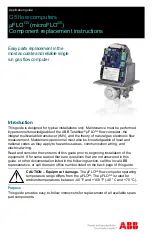
In
situations
where
ESCON
CTC
communication
is
required
among
LPs
that
exist
on
two
or
more
CPCs,
shared
channels
can
reduce
even
further
channel
and
other
hardware
requirements
and
their
associated
cost.
ESCON
CTC
configurations
are
well-suited
to
take
advantage
of
the
consolidation
benefits
associated
with
shared
channels.
CTC/CNC
and
CTC/FCV
pairs
used
for
ESCON
CTC
communications
have
no
limitation
on
the
number
of
logical
paths
that
can
be
established
between
them.
The
only
limitations
are
the
number
of
control
units
that
can
be
defined
for
an
ESCON
CTC
channel
and
the
performance
expectations
you
determine
for
your
configuration.
Infrequently
Used
ESCON
or
FICON
Control
Units:
ESCON
or
FICON
control
units
not
frequently
used
can
make
use
of
shared
channels.
You
can
attach
such
a
control
unit
to
a
shared
channel
that
is
also
attached
to
other,
more
frequently
used
control
units
without
adding
greatly
to
the
channel
utilization
of
the
shared
channel.
The
control
unit
within
the
Director
is
a
good
example
of
this.
Notes:
1.
You
cannot
define
a
control
unit
(or
multiple
control
units
with
common
I/O
devices)
to
a
mixture
of
shared
and
unshared
channel
paths
in
the
same
IOCDS.
2.
You
cannot
define
more
than
one
control
unit
with
the
same
CUADD
to
the
same
link
on
a
Director
(or
point-to-point)
if
the
attaching
CHPIDs
are
shared.
Unshared
ESCON
or
FICON
Channel
Recommendations
Not
all
ESCON
or
FICON
configurations
benefit
from
the
use
of
shared
channels.
There
are
some
configurations
where
use
of
an
unshared
channel
is
more
appropriate.
Consider
the
following:
v
Logical
Path
Limitations
of
the
Control
Unit
While
many
ESCON
control
units
can
communicate
with
multiple
LPs
at
a
time
using
multiple
logical
paths,
there
are
some
ESCON-capable
control
units
that
can
only
communicate
with
one
LP
at
a
time.
For
example,
consider
the
3174
Establishment
Controller
(Models
12L
and
22L).
When
configured
in
non-SNA
mode,
the
3174
establishes
only
one
logical
path
at
a
time.
A
shared
channel
would
offer
no
connectivity
benefit
in
this
situation.
However,
if
you
defined
an
unshared,
reconfigurable
channel
to
the
3174,
it
would
allow
you
to
dynamically
reconfigure
the
channel
for
any
LP
that
had
to
communicate
with
the
3174
at
a
given
time.
v
Channel
Utilization
Typically,
the
channel
utilization
of
shared
channels
will
be
greater
than
unshared
channels.
If
you
use
shared
channels
to
consolidate
channel
resources,
you
must
consider
the
channel
utilization
of
all
the
channels
you
consolidate.
The
channel
utilization
of
a
shared
channel
will
roughly
equal
the
sum
of
the
channel
utilizations
of
each
unshared
channel
that
it
consolidates.
If
this
total
channel
utilization
is
capable
of
decreasing
performance,
you
should
consider
using
unshared
channels
or
a
different
configuration
of
shared
and
unshared
channels
to
meet
your
connectivity
needs.
Dynamically
Managed
CHPIDs
A
key
aspect
of
the
Intelligent
Resource
Director
(IRD)
provided
by
z/OS’s
WLM
component
is
Dynamic
CHPID
Management
(DCM).
DCM
provides
the
ability
to
have
the
system
automatically
move
the
available
channel
bandwidth
to
where
it
is
Chapter
2.
Planning
Considerations
2-27
Summary of Contents for Z9
Page 1: ...System z9 Processor Resource Systems Manager Planning Guide SB10 7041 03...
Page 2: ......
Page 3: ...System z9 Processor Resource Systems Manager Planning Guide SB10 7041 03...
Page 12: ...x PR SM Planning Guide...
Page 18: ...xvi PR SM Planning Guide...
Page 26: ...xxiv PR SM Planning Guide...
Page 54: ...1 28 PR SM Planning Guide...
Page 126: ...2 72 PR SM Planning Guide...
Page 220: ...4 8 PR SM Planning Guide...
Page 232: ...5 12 PR SM Planning Guide...
Page 250: ...B 16 PR SM Planning Guide...
Page 266: ...D 10 PR SM Planning Guide...
Page 272: ...X 6 PR SM Planning Guide...
Page 273: ......
Page 274: ...Printed in USA SB10 7041 03...
















































